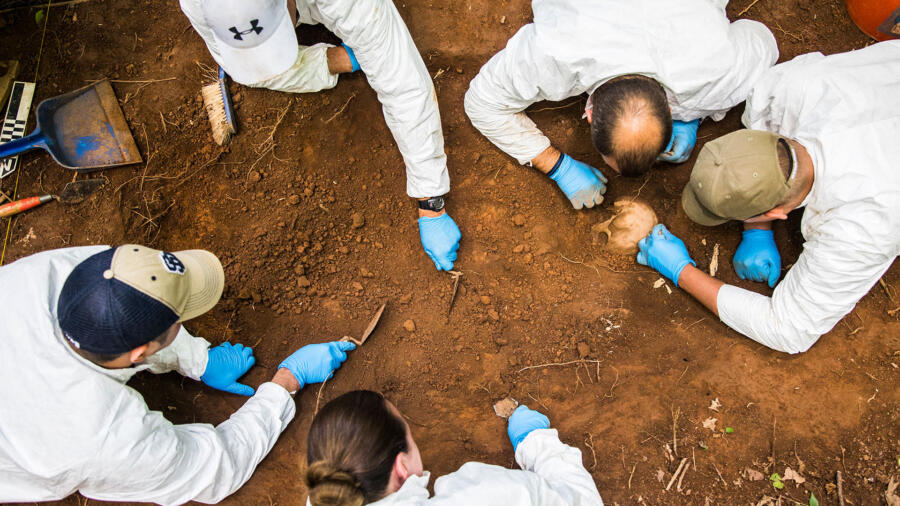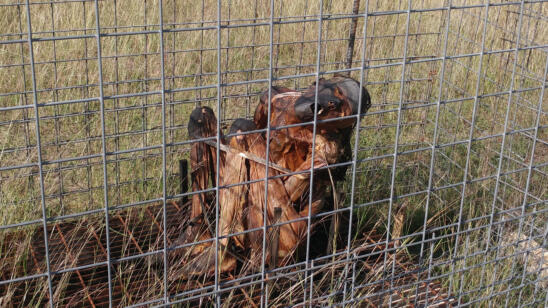It’s another packed morning at the University of Tennessee, Knoxville, where forensic anthropologist Dawnie Wolfe Steadman is juggling Zoom meetings, a media interview and graduate students.
There’s also the phone to monitor. You never know when someone will donate their body.
“The heart and soul of the Forensic Anthropology Center is our body donation program,” professor and FAC Director Steadman tells A&E True Crime.
“Without the generosity of people who want to donate their bodies for the purpose of forensic science research, we wouldn’t be able to do any of the research or training that we do,” she says.
About 100 new donor bodies a year are received at the university’s Anthropology Research Facility, known colloquially as the “Body Farm,” a 2-acre outdoor site.
As bodies decompose, they yield knowledge that advances science and helps to solve crimes.
“They donated their bodies to science so that somebody could learn, and that’s our responsibility. To learn something from every donor—and we do,” Steadman says.
Life After Death
There are currently seven body farms across the U.S., but the University of Tennessee’s is the first, founded in 1987 by anthropologist William M. Bass, a pioneer in human decomposition research.
About 5,000 “pre-donors” have committed their bodies to the facility. One important part of registration is providing a medical history to help maximize research potential. Among the participants are police officers, service members, health care professionals and teachers.
“They feel this is a way they can still be teaching after they’re gone,” Steadman says.
On any given day, FAC team members could be on the phone with living donors or receiving deceased ones. Researchers take photographs, enter details like height and weight into a massive database then transfer donors to the Anthropology Research Facility.
Bodies are used for multiple studies and could be placed out in the open, buried, covered with plastic or put inside a car, for example. The facility accommodates about 200 bodies and as they break down, researchers from UT and across the world are watching and documenting changes.
Narrowing Time of Death
One significant study near conclusion is aimed at estimating a more accurate time of death by examining how medications, such as painkillers, affect the insects and bacteria that aid in body decomposition.
Medications that repel female flies could delay when they lay eggs or could impact the size of the maggots used as a tool to deduce when someone died.
“Our hypothesis is that these intrinsic factors—especially drugs—can really change how the bacteria are responding, how the insects are responding and throw off all of our methods for estimating PMI (post-mortem interval),” Steadman says. “That’s the time period between when an individual was last known alive and when their body was discovered.”
The findings could help determine guilt or innocence in homicides.
According to Steadman, a suspect may profess, “It wasn’t me. I was in England for the last two weeks.” “But we can say, ‘Well, actually, it’s [been] more like six weeks since this individual died.'” Steadman explains. “That suspect may now be back in the pool.”
Clues in Plant Color
A new research project looks at whether fluids produced by decaying bodies affect the color of a tree’s leaves.
“I’m not exactly sure, honestly, what we’re going to end up with,” Steadman says. “My guess is we’re going to see an uptake in nitrogen in the plants…but there could be other chemical signatures as well. And that does change how the chlorophyll works and, therefore, it changes the pigmentation of the leaves.”
The end result could help police locate missing people using drones equipped with technology that detects abnormal leaf colors, indicating a body.
“If you’re looking at 100 acres, and we could maybe narrow it down to a few target areas, that’s going to save hundreds of man-hours of searching,” Steadman says.
Donors also provide unique training for law enforcement. The FBI, for one, regularly sends agents to learn correct methods for documenting and recovering evidence from secretly created burial sites.
The training is crucial, said Kacey Gabriel, head of the FBI Laboratory’s forensic response section. “Any mistakes made during the crime scene process could render evidence useless in court,” Gabriel explained in an agency publication.
Testing the Limits of Technology
Back on campus, another responsibility for FAC staff members is documenting the skeletons into the Bass Donated Skeletal Collection when decomposition is complete.
Skeletons are cleaned, labeled and stored, and the information is entered into a database used by scholars in the U.S. and globally.
The collection—which is comprised of about 2,000 skeletons—is “for the entirety of the academic world to use,” Steadman says. “There’s really no end to the type of research that can be done.”
This winter, one University of Tennessee, Knoxville, graduate student is working on a master’s thesis testing the limits of 3D imaging of bones.
“We can take 3D images of a skeleton and send it to a researcher in Australia, and they can still do measurements on it,” Steadman says. But—”can you still see those same features as accurately on these 3D images as you can on the dry bone?”
Shedding light on shortcomings in new technology is essential, she says, “so people aren’t misinterpreting that data or thinking it’s this silver bullet that’s going to solve all our problems.”
‘Redheaded Murders’ Victim Identified
FAC anthropologists also assist police with cold cases.
In 2018, FAC Associate Director Lee Meadows Jantz helped identify a young woman believed to have been a victim in the “Redheaded Murders,” a number of mysterious slayings in Southern states from 1978 to 1992.
The woman’s name was Tina Marie McKenney Farmer. In 1985, her body was found along Interstate 75 near Jellico, Tennessee, close to the Kentucky border.
Police brought Farmer’s remains to university anthropologists, who determined her age was 20. She remained in the skeletal collection, anonymous, until Tennessee Bureau of Investigation officers, following a new lead, asked the FAC to assist.
Another unknown female skeleton left with the university in the 1980s was revealed three years ago to be a 15-year-old girl from New Hampshire. The teenager had run away from home and was later murdered. Her brothers gave DNA samples to authorities that matched information the FAC had provided to a national database, Jantz tells A&E True Crime.
Such discoveries are why Jantz went into forensic anthropology. “I really wanted to work…to help families and individuals who died alone come back together,” she says.
‘I’m Not in That Body Anymore’
Every individual who enrolls in the donation program receives a card with instructions on what their families or friends should do with their bodies when they die.
“Most of our donors are proud, card-carrying pre-donors,” Steadman says. “They are a very enthusiastic group.”
Facility scientists also are collecting biological information from participating donors for a study of biometric devices (security or authentication devices that can recognize the identity of a person). The aim is to measure how the devices match features, such as fingerprints, of living and deceased individuals.
“If we can help move this science along, it could be that police officers can come up to a decomposing body on scene, take the fingerprints from that body—and maybe, right there, get a match if they can put that into their fingerprint system,” Steadman says.
Several times a year, the FAC hosts pre-donor events where they meet with forensic anthropologists and tour the labs.
“They are our favorite days of the year,” Steadman says. Some pre-donors “have an interest in forensic science and helping the criminal justice system. Sometimes it’s because they or somebody else they know has been a victim or has otherwise been embroiled in the criminal justice system.”
Others are more metaphysical, explaining, “‘I’m not in that body anymore. You guys can do what you want with it to teach and learn,'” Steadman recounts. “Whatever the motivation, we’re extremely grateful.”
Related Features:
6 Body Farm Experiments That Could Help Solve Crimes
Down on the Body Farm: Bodies ‘Eat Themselves’ While Researchers Watch and Learn


